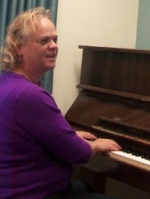
Mix Margaret Dylan Jones
W.A. composer, pianist, teacher, article writer
Specialist in solving singing problemsfor a wide range of musical styles
Singing Lessons: Reading About It's
Not The Same
Why is reading or hearing about it not the same as having a one-to-one voice lesson?
These days there are lots of DVDs or online courses promising to turn you into a great singer, in record time (for example, by last Thursday, just in time for a weekend engagement).
And there are websites, such as this one, where you can read pages and pages of information about singing technique and vocal health.
The essential problem is that you really need someone to observe you while you sing, or speak. You need a teacher listening to your voice and watching how you use your body. You need them asking all the right questions to figure out what you're trying to do, and what you think you're doing, which may not be not at all what you are really doing. It doesn't matter how detailed the written instructions are, an experienced ear and eye is required to monitor you.
Then there is the major problem of terminology. If you read about voice placement, will you know what they're talking about? Or vocal colours and resonance? Even if there was an audio or video recording on this site to illustrate these teaching points, recordings are nothing like live sounds. Anything coming out of a speaker can be quite misleading in several ways.
Much of the language that is used in a singing or speech lesson is hard to understand correctly outside the context of the studio. In music generally, many terms are borrowed from other fields, especially the visual arts, and the meanings of these terms when used in music are not easily defined. For example, we talk a lot about tone colour, texture, and brightness. But what do they sound like? How do you assess or categorize them? And what do they feel like to the person who is singing?
Two strategies help me deal with this problem in my own teaching. Firstly, I try to stick to the facts as much as possible. I'll never tell you to "breathe into your stomach," for example, because I'm not trying to make you burp. If you're at the stage to be developing more of a ringing quality, I'll explain to you the singer's formant, which is an intense and high-pitched component of the sound. Then I'll demonstrate how it sounds, and guide you in the muscular manoeuvres required to produce it.
Don't get me wrong, use of imagery is still important. It can really help people to access the fine control of certain muscles. For example, when teaching retraction of the ventricular (false) folds I'll ask students to 'make the throat smile.' Your throat can't smile, but this imagery can help you can get the idea of using a certain kind of appropriate and very important muscular effort at the level of the larynx.
The second strategy is to help each student develop an understanding of the meaning of each term. For example, in speech exercises many students are not accustomed to listening for pitch as a separate quality, they get it mixed-up with tone colour. After some discussion and trial and error, possibly over several lessons, the student learns to make the distinction between the two.
Students may have heard all sorts of things, wild and wonderful, from other sources and may not understand common terms the same way as myself. So, coming to a understanding of what we're talking about is important, which you can't do via a pre-recorded video.
A teacher will need to ask what your aims are, and what your vocal history is, in order to guide you. A video can't do that either.
I've just explained why you really need personal lessons. However, there is a video series I recommend to all my students by Per Bristow called The Bristow Voice Method or The Singing Zone. He is not only a master voice teacher, he's a master communicator and has an amazing ability to explain and demonstrate via video.
It makes an excellent home study course that you can use alongside having individual lessons. Just make sure your teacher has a compatible approach to Bristow. The course includes ear-training and music theory (rhythm school and sight-reading). Read my review of it here.
| Twitter: MixMargaretand |
About PeopleString. Try PeopleString.
http://facebook.com/MixMargaret
Please make suggestions on how to improve this site.

Online Vocal Resources
Professional Services
All about Margaret
Third party
products & services
The Singing Zone
Per Bristow's
home study
voice method
My sites
PIANO PAGES HOME
SINGING SITE HOME
RESOURCE REVIEWS HOME
Combined Entry Portal
Combined Sites List